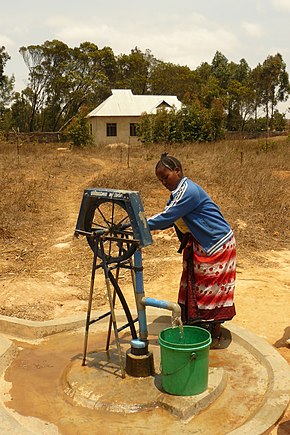
Self-supply of water and sanitation (also called household-led water supply or individual supply) refers to an approach of incremental improvements to water and sanitation services, which are mainly financed by the user.[1][2] People around the world have been using this approach over centuries to incrementally upgrade their water and sanitation services.[3] The approach does not refer to a specific technology or type of water source or sanitation service although it does have to be feasible to use and construct at a low cost and mostly using tools locally available. The approach is rather about an incremental improvement of these services. It is a market-based approach and commonly does not involve product subsidies.
"Self-supply" is different from "supported self-supply." The first term refers to situations where people improving their water and sanitation services on their own. "Supported self-supply" refers to a deliberately guided process, usually by a government agency or a non-governmental organization.[3] Many examples of self-supply taking off in a short time come from situations where government-led service provision broke down (e.g., in countries of the former Soviet Union[4]). The approach can also be deliberately used by government agencies or external support agencies to complement other types of service provision, such as community-managed water supply.
Self-supply is an important strategy - in combination with other approaches such as community-managed services - to achieve the United Nations Sustainable Development Goals, particularly for Goal number 6: "Ensure access to water and sanitation for all".[3]
The term is commonly used in the water sector in the development cooporation context, but less commonly in the sanitation sector. Certain approaches such as community-led total sanitation or container-based sanitation systems have many similar aspects to self-supply. Some organizations use other terms referring to approaches which are led by individual households. For example, the World Health Organization uses the term "individual supply".[5] In the context of developed countries, a related concept is called living "off the grid".
- ^ Rural Water Supply Network. "Rural Water Supply Network Self-supply site". www.rural-water-supply.net/en/self-supply. Retrieved 2017-03-19.
- ^ Sutton, Sally (2021). Self-Supply : filling the gaps in public water supply provision. Practical Action Publishing. ISBN 978-1-78044-819-0. OCLC 1239689655.
- ^ a b c Olschewski, A. (2016). A business case for supported Self-supply as service delivery approach to achieve SDGs. Skat Foundation, Switzerland, 7 th RWSN Forum “Water for Everyone” 7 ème Forum RWSN « L’eau pour tous » 29 Nov - 02 Dec 2016, Abidjan, Côte d’Ivoire
- ^ Olschewski, Andre (2016), Supported Self-supply – learning from 15 years of experiences (PDF)
- ^ Richtert, Bettina; et al. (2016), Status of Small-scale Water Supplies in the WHO European Region (PDF)